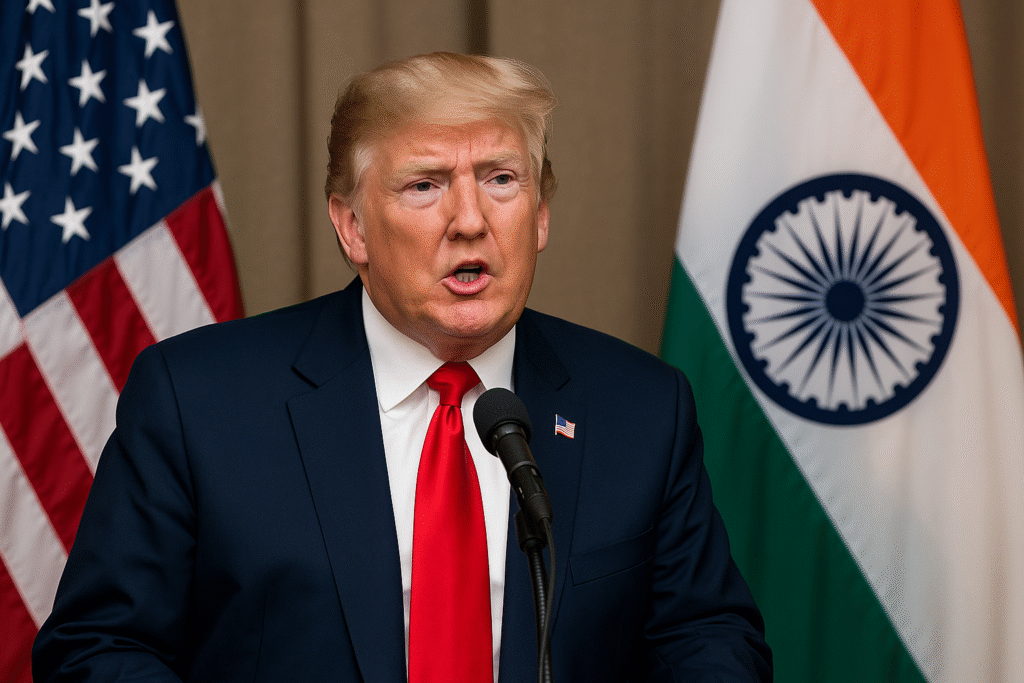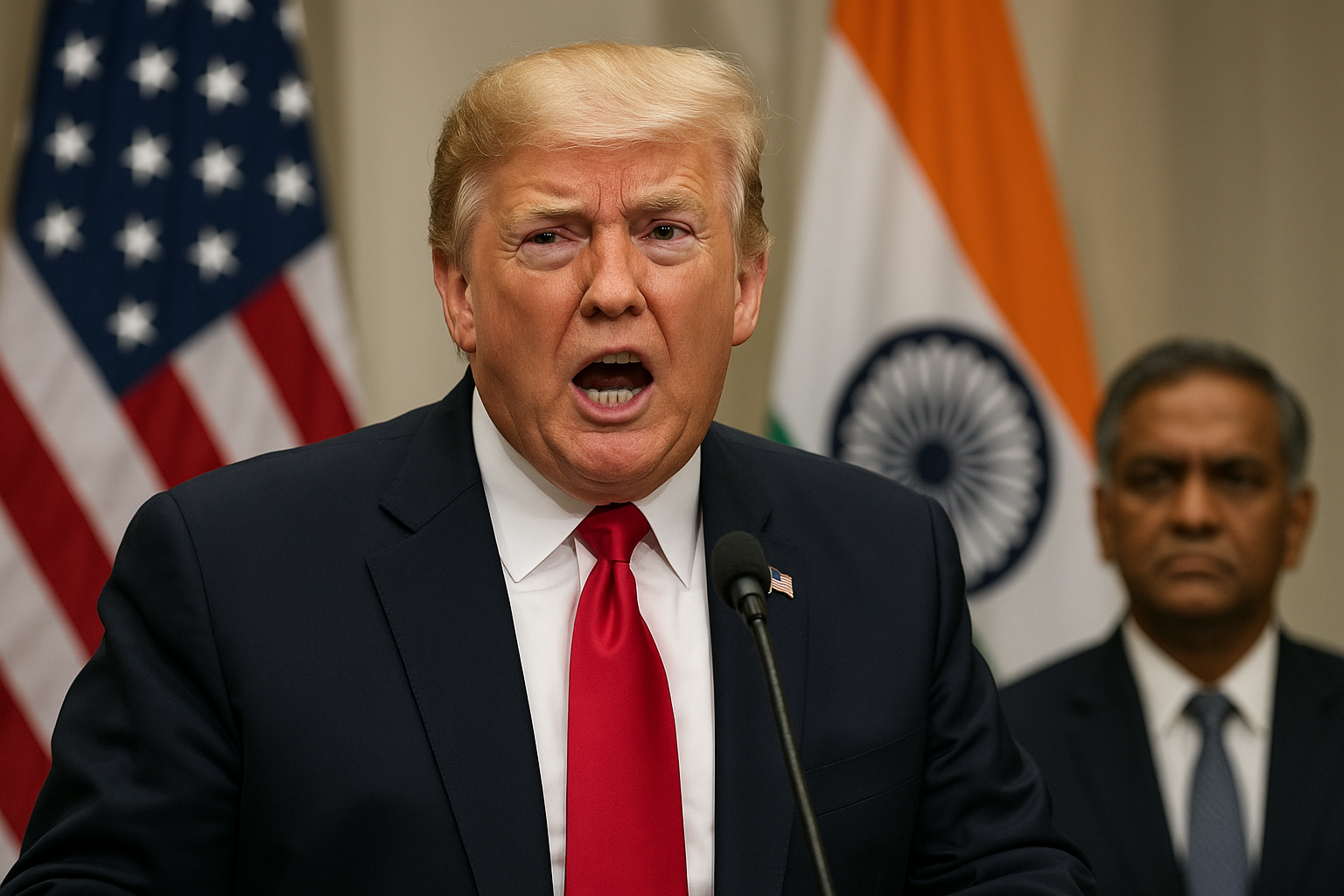Trump India Tariff Rift: In August 2025 the United States dramatically raised duties on many Indian imports — adding an extra 25% on top of earlier tariffs so that some Indian goods now face duties of up to 50% when entering the U.S. That move, framed by Washington as a tool to punish India for continuing to buy discounted Russian oil, immediately triggered sharp rhetoric, economic concern and what President Donald Trump himself called “a rift with India.” This article walks through the who, what, why and now — the legal basis, the economic fallout, the diplomatic consequences, and what we should all watch for next.
1) What exactly did Washington do?
In early August 2025 the White House issued an executive order that authorized additional ad valorem duties on imports from India, citing India’s continued purchases of Russian oil as a national-security and foreign-policy concern. Those measures added 25 percentage points to previously announced tariff actions — bringing the total to as high as 50% on many Indian exports to the U.S. — and took effect later in the month. The administration also signaled a process for potential similar measures against other countries that continue to import Russian crude.
2) Why the U.S. framed the move as necessary
According to the White House fact sheet and subsequent administration statements, the rationale is geopolitical: the U.S. argues that purchases of Russian oil provide revenue that helps Moscow continue its war in Ukraine. The tariffs are presented as an economic lever to deter third-party purchases of Russian energy — essentially a secondary sanction executed through trade policy rather than banking or asset freezes. The administration said it believed the extraordinary steps were required to address a continuing national emergency related to Russia.
3) Why President Trump says the tariff “caused a rift with India”
When asked about the tariffs in media interviews, President Trump acknowledged the political cost of the additional duties, calling them a “big deal” and saying they had strained ties with New Delhi. That language reflects two realities: (a) the tariffs directly hit sectors important to India’s exporters and their workers, and (b) they came at a time of deepening strategic cooperation between Washington and New Delhi — so the move exposed a sharp policy mismatch between a U.S. desire to punish Russian energy links and India’s insistence on “strategic autonomy” in sourcing energy. In short, Washington’s policy objective collided with India’s national-energy priorities, and the rhetoric from both capitals quickly hardened.
4) The legal and administrative basis — how the U.S. imposed the tariff
The White House used national-security and emergency authorities (an executive order) to impose the additional duties. This is not unprecedented — presidents have used similar authorities in trade emergencies — but such measures are controversial because they bypass the usual congressional trade process and because they can be applied quickly and broadly. The executive action contained implementation details (what categories would be targeted, timelines and exemptions) and allowed for follow-up administrative steps, including consultations and carve-outs for critical sectors.

5) What sectors and exporters are most affected
Analysts and industry groups in India warned the tariffs will hit labour-intensive sectors hardest — textiles, leather, gems and jewelry, and certain manufactured goods that make up a large share of India’s exports to the U.S. Some estimates suggested the duties could impact roughly half of India’s exports to America (estimates ranged around tens of billions of dollars). Indian authorities and exporters immediately warned of job losses and supply-chain dislocations if buyers shift orders to alternative suppliers such as Vietnam, Bangladesh or China.
6) Economic fallout — what India and markets said
India’s chief economic adviser and other policymakers publicly warned the tariffs could shave tenths of a percentage point off India’s GDP growth in the fiscal year — a non-trivial effect for an economy depending on manufacturing and export-led jobs in many regions. Market watchers also flagged the risk of disruptions to long-standing supply chains, with multinational firms reconsidering sourcing strategies and near-term volatility in sector stocks tied to Indian exports. At the same time, commentators noted that India remains the fastest-growing major economy in 2025 and has buffers — but the tariffs are nevertheless a strategic shock.
7) India’s response — diplomacy, domestic politics, and markets
New Delhi publicly called the measures “unjustified” and emphasized its right to pursue affordable energy in national interest. India also moved quickly to explore damage-mitigation: engaging trade partners in Asia and Europe, accelerating talks to diversify markets, seeking exemptions for certain critical sectors (pharmaceuticals and electronics were reportedly given special attention), and preparing contingency plans for impacted exporters. Politically, the tariffs became fodder for domestic debate — both as an economic challenge to exporters and as an assertion of India’s strategic autonomy.
8) Geopolitical consequences — is the strategic partnership at risk?
The U.S.–India relationship before August 2025 had become multifaceted: shared strategic interests in the Indo-Pacific, defence cooperation, and deepening commercial ties. The tariff escalation introduced friction into that broader relationship. Key questions now: will deeper security cooperation (arms sales, naval exercises) continue apace despite trade rancour? Will both sides compartmentalize — allowing defence and security ties to move forward while trade cools — or will trade pressures bleed into other areas including defence procurement and diplomatic coordination? For now, officials in both capitals say they want to manage the dispute — but President Trump’s public admission that the tariffs “caused a rift” underscores the seriousness of the rupture.
9) Who else is watching — Europe, China and the G7 angle
The U.S. also tried to marshal international support for stronger actions on Russian oil purchases, urging G7 partners to consider punitive measures. European governments were cautious: while many have moved aggressively away from Russian energy, they are wary of unilateral secondary measures that could destabilize markets and invite retaliatory trade actions. China and other energy buyers are also watching closely — some analysts argued the tariffs may accelerate China’s and India’s efforts to deepen trade ties with other partners and to reduce dependence on the U.S. market for certain goods.
10) Practical takeaways for businesses, consumers and policymakers
- For exporters in India: Diversify customers, accelerate access to alternative markets, and push for government support (logistics subsidies, market diversification programs).
- For U.S. importers and retailers: Reassess supply chains and costs — product prices might rise if duties are passed to consumers. Consider nearshoring or alternative sourcing.
- For policymakers: Pursue back-channel diplomacy to de-escalate, consider targeted carve-outs for essentials, and engage industry stakeholders to manage short-term shocks.
- For investors: Watch sector exposure (textiles, gems, leather), currency flows, and any signs of retaliatory tariffs that could widen the trade dispute.
11) What happens next — scenarios to watch
- De-escalation through diplomacy: Quiet talks between Washington and New Delhi produce narrow exemptions or a phased rollback conditional on India reducing Russian oil imports.
- Prolonged stalemate: Tariffs remain and firms divert supply chains to other countries, producing longer-term realignment.
- Escalation and retaliation: India responds with its own trade measures (less likely for now but possible if political pressure mounts).
- Multilateral action: The U.S. succeeds in rallying at least some G7 partners to amplify pressure on Russian energy buyers, changing the strategic calculus.
Each path carries its own economic and geopolitical consequences; businesses and governments are already scenario-planning.
Do you think the 50% tariff was the right move?
Sources & checked links (only valid, authoritative pages)
Below are the primary sources used to compile this update. Each was available and checked in September 2025:
- White House — Fact Sheet / Executive Order on tariffs and national emergency (August 2025).
https://www.whitehouse.gov/fact-sheets/2025/08/fact-sheet-president-donald-j-trump-addresses-threats-to-the-united-states-by-the-government-of-the-russian-federation/ (The White House) - Reuters — “Trump’s doubling of tariffs hits India, damaging ties.” (Aug 27, 2025).
https://www.reuters.com/world/india/trumps-doubling-tariffs-hits-india-damaging-ties-2025-08-27/ (Reuters) - Associated Press — “Trump’s 50% tariffs on India over Russian oil purchases take effect.” (Aug 27, 2025).
https://apnews.com/article/india-us-tariff-exports-trade-tension-48ac6d5e172df04832c75d2a57d0a860 (AP News) - Financial Times — coverage of broader G7/tariff diplomacy and global reaction (September 2025).
https://www.ft.com/content/51ea9210-078f-42d7-a4ba-5ad985902761 (Financial Times) - Al Jazeera — “US raises India tariffs to 50% over Russian oil purchases.” (Aug 27, 2025).
https://www.aljazeera.com/news/2025/8/27/us-imposes-50-percent-tariff-on-india-over-russian-oil-purchases (Al Jazeera) - Reuters / India economic reaction — India’s chief economic adviser on GDP impact (Sept 2025).
https://www.reuters.com/world/india/indias-chief-economic-adviser-says-trumps-tariffs-could-shave-05-off-gdp-2025-09-08/ (Reuters)
Quick editorial note
This article aims to explain the facts, context, and likely economic and diplomatic consequences of the tariff escalation described above. It does not advocate a policy position; instead it summarizes official statements, economic estimates, and authoritative reporting to help readers understand the practical stakes of the “Trump India tariff rift.”
Disclaimer
This article is informational and reflects reporting and official statements available as of September 2025. It is not legal, financial, or investment advice. For decisions that could affect your business or legal standing, consult qualified professionals. TrenBuzz.com is not responsible for subsequent developments or corrections issued by governments or news organizations after publication. Images used in this article are AI generated, royalty‑free or licensed for commercial use and are provided here for illustrative purposes.
